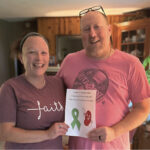I bristled at my doctor.
“A statin?” I huffed. “For me?”
It was during a telehealth appointment in 2021, months after a medical exam for my new life insurance policy flagged an elevated overall cholesterol level of 244 and an alarming LDL (or “bad cholesterol”) level of – gulp – 167. As reference points, anything above 200 overall or 100 LDL is considered high.
Naturally my doctor was concerned, particularly after we’d worked together the previous few years to control my cholesterol through diet. He told me that since that hadn’t worked, it was time to put me on the statin, a well-known class of drugs that can lower cholesterol by blocking a substance the body uses to produce it.
I should have felt good about taking a medication I already knew was affordable and wildly effective. Instead, I was frustrated – and felt like a failure.
Over the previous four years, I’d dropped more than 30 pounds to get to the healthy weight my doctor wanted; intensified my exercise; and limited my intake of high-LDL culprits like cream and cheese.
And still I needed these pills? Weren’t statins for people struggling more with their weight, exercise, and diet? Weren’t they for smokers?
My doctor doubled down.
“Jerry, listen,” he said. “This could just be something out of your control. I can tell you just by looking at your cholesterol number and your demographics – your age (55 at the time), your race, your gender – that your probability of having a heart attack or stroke over the next decade is something like 12%. It shouldn’t be higher than 5%.
“It’s time to take the statin.”
Sufficiently terrified, I finally took the statin.
Not Always about Lifestyle
Turns out I’m far from alone.
My story serves as a reminder that while high cholesterol is often the result of the aforementioned lifestyle factors, it can simply be hereditary.
That’s the case for me and tens of millions of Americans, and a reason the American Heart Association (AHA) recommends all adults 20 and over have preventive cholesterol screenings every four to six years.
An estimated 12% of Americans, about 94 million, have high cholesterol. Because it comes without noticeable symptoms, it’s particularly perilous if left untreated – excess LDL can build and ultimately block a coronary artery, triggering heart disease and strokes.
Costly but Containable
An AHA-funded report found that high cholesterol would cost the United States $276 billion in lost productivity by 2030. But it need not cost so many lives and so much money, because experts agree on several effective approaches:
- Take medications when prescribed. I finally succumbed to reality and did what was best for my health. But according to the Centers for Disease Control and Prevention, 45% of U.S. adults who could benefit from cholesterol medications don’t take them.
- Maintain a diet low in saturated fats. Saturated, or “bad,” fats are the main culprits leading to high LDL.
- Manage your weight. Excess body fat often means higher cholesterol.
- Don’t smoke. It makes LDL “stickier,” and more likely to clog arteries.
Health insurance that covers screening, counseling, and treatment is critical to containing high cholesterol.
Capital Blue Cross offers a variety of preventive services with no cost share to members who have standard benefit coverage. Services related to healthy cholesterol levels may include:
- An annual preventive visit to review health, as well as family and personal risk factors.
- Preventive medications such as statins. See a full covered medication list at capbluecross.com.
- A lab test, called a lipid panel, to check cholesterol levels.
- Blood pressure screenings.
- Screening and behavioral counseling for cardiovascular disease prevention.
So My Statin Worked
My statin – a generic of Lipitor – slashed my numbers to healthy levels within months, making me feel silly for being so prideful and waiting so long.
I’m lucky the issue didn’t create chronic problems, or worse, before I started the prescription, and urge anyone whose doctor recommends medication to take it as prescribed, in addition to doing the other good stuff: Eat healthy, exercise and kick those cigarettes to the curb.
High cholesterol can cause huge problems. But as my journey shows, there’s really no need to let it reach that point.
THINK (Trusted Health Information, News, and Knowledge) is a community publication of Capital Blue Cross. Our mission is to provide education, resources, and news on the latest health and insurance issues.
If you like what we do, please support our work. Become a Friend of TheBurg!






